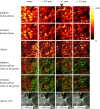Exploring the geochemical distribution of organic carbon in early land plants: a novel approach
- PMID: 29254964
- PMCID: PMC5745335
- DOI: 10.1098/rstb.2016.0499
Exploring the geochemical distribution of organic carbon in early land plants: a novel approach
Abstract
Terrestrialization depended on the evolution of biosynthetic pathways for biopolymers including lignin, cutin and suberin, which were concentrated in specific tissues, layers or organs such as the xylem, cuticle and roots on the submillimetre scale. However, it is often difficult, or even impossible especially for individual cells, to resolve the biomolecular composition of the different components of fossil plants on such a scale using the well-established coupled techniques of gas chromatography/mass spectrometry and liquid chromatography/mass spectrometry. Here, we report the application of techniques for surface analysis to investigate the composition of Rhynia gwynne-vaughanii X-ray photoelectron spectroscopy of two different spots (both 300 µm × 600 µm) confirmed the presence of carbon. Time-of-flight secondary ion mass spectrometry (ToF-SIMS) revealed 'chemical maps' (imaging mode with 300 nm resolution) of aliphatic and aromatic carbon in the intact fossil that correlate with the vascular structures observed in high-resolution optical images. This study shows that imaging ToF-SIMS has value for determining the location of the molecular components of fossil embryophytes while retaining structural information that will help elucidate how terrestrialization shaped the early evolution of land plant cell wall biochemistry.This article is part of a discussion meeting issue 'The Rhynie cherts: our earliest terrestrial ecosystem revisited'.
Keywords: Rhynia gwynne-vaughanii; X-ray photoelectron spectroscopy; terrestrialization; time-of-flight secondary ion mass spectrometry; ‘chemical maps’.
© 2017 The Author(s).
Conflict of interest statement
We declare we have no competing interests.
Figures





References
-
- Kenrick P, Crane PR. 1997. The origin and early evolution of plants on land. Nature 389, 33–39. (10.1038/37918) - DOI
-
- Edwards D, Cherns L, Raven JA. 2015. Could land-based early photosynthesizing ecosystems have bioengineered the planet in mid-Palaeozoic times? Palaeontology 58, 803–837. (10.1111/pala.12187) - DOI
MeSH terms
Substances
LinkOut - more resources
Full Text Sources
Other Literature Sources

